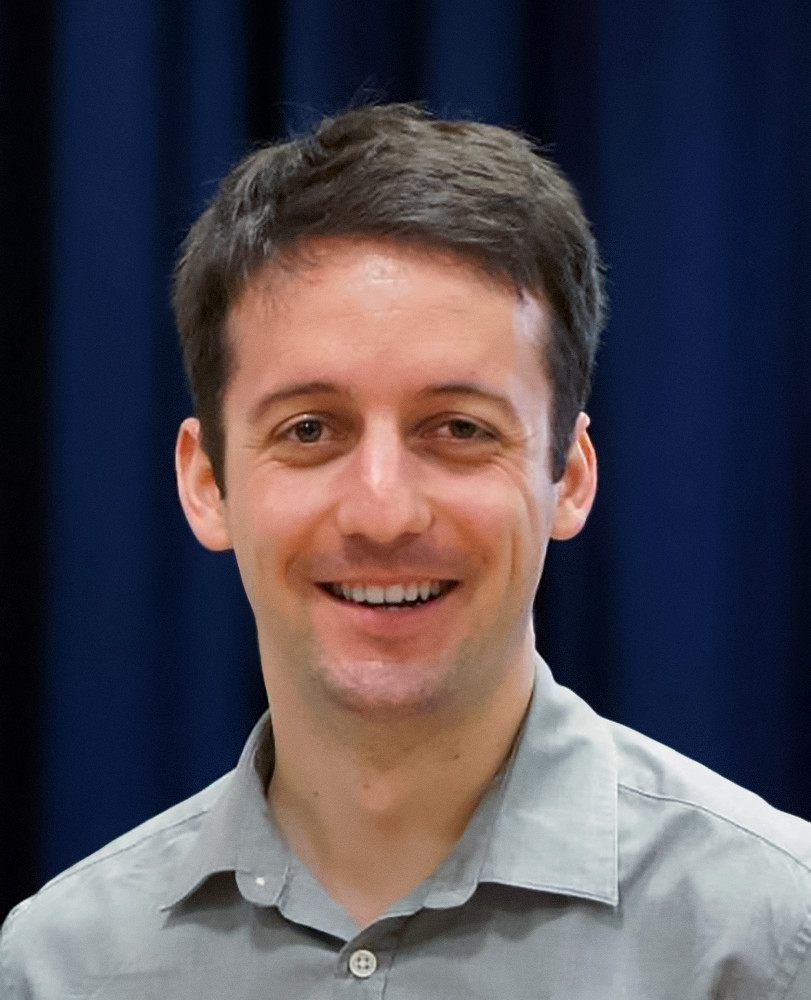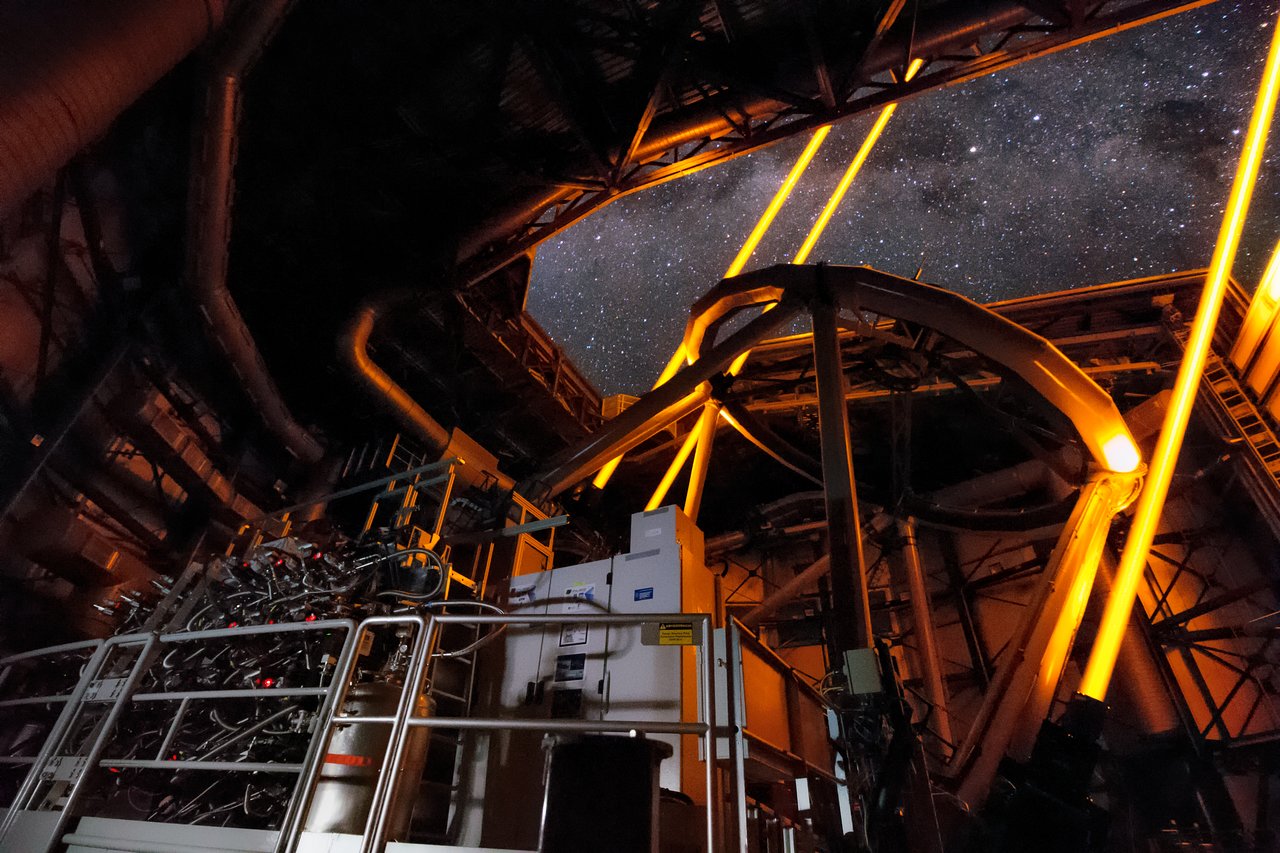
Next-generation Lasers Shine Spotlight On Classical Physics
A conversation with ESO Fellow Frédéric Vogt
- What it’s like to be an ESO Fellow in Chile
- How the 4 Laser Guide Star Facility operates
- The ways in which new astronomical instruments can unearth unexpected observational challenges
Q: Let’s start with an introduction. You’re an ESO Fellow in Chile — tell us about that experience.
A: I joined ESO in late 2015, after finishing my PhD in Astrophysics at the Australian National University. I’m part of the Unit Telescope 4 (UT4) team at the Very Large Telescope (VLT) and I support all of its operations, whatever they may be, including observations in service or visitor mode, technical tests, and commissioning of new systems. I’m originally from Switzerland and I have a background in integral field spectroscopy, so the UT4 (home to the instruments MUSE, SINFONI and HAWK-I) couldn’t be a better match for my skills and interests! Getting to know MUSE inside-out, in all its intricacies, was actually my primary motivation for joining ESO.
When I’m not up on the mountain, I spend my time at ESO’s Chilean headquarters in Santiago, working on my own scientific research. Part of my expertise lies in studying the abundance of heavy elements in the interstellar gas in galaxies within about 300 million light-years of Earth. The fine spatial resolution of MUSE allows me to look at such galaxies and their components in greater detail than ever before, which helps me learn more about how they evolve over time. Lately, I’ve also been spending time on an older topic of interest: young supernova remnants. We can use MUSE to study the outer layers of massive stars that exploded about 2000–5000 years ago, which tells us a lot about what was happening within the stars before they went supernova — as well as the mechanisms of the explosions themselves.
Q: Part of your duties focuses on the 4 Laser Guide Star Facility. Why is this system so important to the VLT’s operation?
A: The 4 Laser Guide Star Facility (4LGSF) is part of the UT4’s new Adaptive Optics Facility. Together with the Deformable Secondary Mirror and dedicated Adaptive Optics modules, it works to reduce the impact of atmospheric turbulence on scientific observations made with the instruments MUSE and HAWK-I. In effect, it allows the UT4 to take “sharper” images. For those keen to know more about the AOF in general, Harald Kuntschner and Robin Arsenault recently discussed it in this ESOblog post.
The 4LGSF itself is composed of four 22-watt lasers, each with its own launch telescope, steering system, and associated electronics. The lasers shine at the very specific wavelength of 589 nanometres, which is used to excite atoms of sodium in a thin layer of atmosphere about 90 kilometres off the ground, causing the atoms to glow. This creates four artificial points of light — four "laser guide stars” — above the telescope, which the Adaptive Optics modules use to measure the atmospheric turbulence in real time, and work out — once every thousandth of a second! — how to deform the secondary mirror to correct for the turbulence.
In effect, the 4LGSF improves the performance of the UT4 by removing some of the effects of the atmosphere, without actually moving the telescope any higher!
Q: What motivated you to look at how these lasers could affect observations in other ways?
A: This is one of the very first times that a laser-based Adaptive Optics system has been used together with an optical instrument. Other Adaptive Optics systems, both at the VLT and other observatories, have been designed to “feed” infrared instruments that aren’t sensitive laser light, but since MUSE is sensitive to light with wavelengths from about 475–935 nanometres, it can actually “see” the lasers of the 4LGSF. So we set out to understand the full extent of this symbiotic relationship between MUSE and the 4LGSF — how do they influence each other, and how does it affect observations?
For the 4LGSF, this was actually part of the battery of tests that every new system has to undergo before being used in the VLT’s regular operations. These “commissioning” tests not only ensure that all instruments are working to the best of their capabilities, but also that they are fully characterised so the astronomy community can immediately make the best possible use of new tools like the 4LGSF.
Q: What was the result of your study?
A: Our team worked out how much laser light is seen by MUSE and noticed that the laser beams of the 4LGSF are not only visible at the laser’s precise wavelength, but also at a handful of other wavelengths thanks to a phenomenon called Raman scattering.
When we use the 4LGSF system, the most noticeable features are the four orange laser beams rising up in the sky. These beams appear to “shine” because the laser photons scatter elastically off (i.e. “bounce off”) air molecules or dust grains in the lower atmosphere, then reach your eyes or camera. These physical mechanisms are known as Rayleigh and Mie scattering, respectively. At the same time, a small fraction of laser photons scatter “inelastically” off air molecules. In doing so, they lose some of their energy to excite a molecule of air (for example, N2, O2, H2O or CO2), and they become a bit redder. This process is known as Raman scattering. It’s seen with MUSE in the form of extra emission lines, redder than that of the laser wavelength.
Q: So in what ways can these lasers affect scientific observations?
A: MUSE is an integral field spectrograph: a special kind of instrument that can take an image of a certain area of the sky, and, at the same time, record the optical spectrum of each “pixel” within this image. In essence, MUSE records datacubes. Imagine the datacube like a sliced loaf of bread, where each “slice” corresponds to the image of the target in a different colour. Using the AOF together with MUSE makes these images sharper by correcting part of the “blurriness” caused by atmospheric turbulence. This is the good part.
But because of Raman scattering, each spectrum in the MUSE datacube will contain a handful of additional emission lines, each associated with a specific type of air molecule that the laser photons interact with. This means that a handful of images from the object (out of the approximately 3700 images in each MUSE cube) will be slightly brighter than they would be without the lasers. This part is not so good!
For most scientific applications, these extra emission lines will have few to no consequences. Of course, there will be specific cases where the astronomical signal of interest is coincident with some of the Raman laser lines. In those cases, the results of the commissioning tests we undertook will help astronomers decide how to best design their observations.
Q: Is this effect new, or were astronomers previously aware of it?
A: This is absolutely not a newly-discovered phenomenon! Our understanding of Raman scattering goes back many decades. On my desk right now is a copy of Molecular Spectra and Molecular Structure (Vol I, Spectra of Diatomic Molecules) — a great read for rainy Saturdays that I’d wholeheartedly recommend to anyone keen to learn about Raman scattering and molecular physics in general. That book dates back to 1950, so this is definitely not a new topic. The physics community has also been using Raman scattering for decades to study the temperature, structure, and molecular composition (including pollutants) of the atmosphere, in cities and elsewhere.
But in the astronomical community, Raman scattering is a phenomenon that has so far been largely overlooked. I think that one of the main reasons for this is that the vast majority of laser-based Adaptive Optics systems have been used to feed infrared instruments, which are oblivious to such emission lines altogether. With MUSE, the physics of Raman scattering is effectively making its big comeback into astronomy.
Q: Can this contamination be reduced?
A: Raman scattering takes place as soon as light propagates through the atmosphere, so we can’t reduce it unless we use less powerful lasers, which would mean we couldn’t robustly correct for atmospheric turbulence. What astronomers and observatories can tackle, however, is how much of the Raman signal enters an instrument. We can implement specific observational procedures and software to correct for the Raman signal in post-processing — and as our latest commissioning test revealed, we should also keep the telescope mirrors as clean and dust-free as possible.
Q: What’s the most interesting part of this research for you?
A: I find it fascinating how long-forgotten physical implications can be revived by new astronomical instruments and systems that are pushing technological limits beyond what was achievable even just a few years ago. Before the arrival of MUSE and the AOF, for example, astronomers didn’t need to think much about Raman scattering. In this case, we’re lucky that the physics behind the phenomenon is already well-understood. But I can’t help wonder what surprises and challenges the next generation of astronomical instruments and telescopes will bring — especially the upcoming class of extremely large telescopes.
As a final note, I’d like to emphasise that these observations were by no means a solitary undertaking. Many people at ESO, both in Chile and Germany, have contributed their skills and expertise to this work. The AOF project itself also goes back many years, long before my arrival at ESO. It has truly been a privilege to sit at the console of the UT4 over the past few months, exploring the limits of the system through purposely-designed (and at times unusual) observations, and seeing this great undertaking come to fruition.
Numbers in this article
|
4 |
Number of lasers in the 4 Laser Guide Star Facility |
|
10+ |
Number of years spent building the Adaptive Optics Facility |
|
589 |
The wavelength of the 4LGSF lasers in nanometres |
|
3700 |
The approximate number of images in each MUSE datacube |
Links
- Find out more about ESO’s Very Large Telescope
- Science paper: “Detection and Implications of Laser-Induced Raman Scattering at Astronomical Observatories”, Vogt et al., Physical Review X, 2017, 7, 021044. DOI: https://doi.org/10.1103/PhysRevX.7.021044
Biography Frédéric Vogt
Frédéric Vogt obtained his PhD in Astrophysics at the Australian National University in Canberra, Australia, in 2015. He joined ESO as a Fellow in December of that year. He is part of the UT4 team at the Very Large Telescope in Paranal: one of several astronomers supporting its operations. With an observational background in integral field spectroscopy, his scientific interests include star formation activity in low-redshift galaxies, and young supernova remnants in our galaxy and in the Magellanic Clouds.
If you like the sound of Frédéric’s work, check out the ESO Fellowship and Studentship Programmes open right now.





